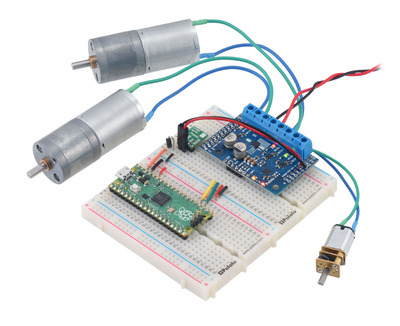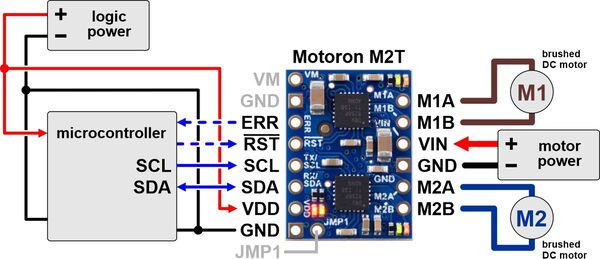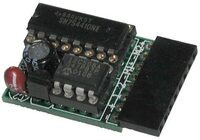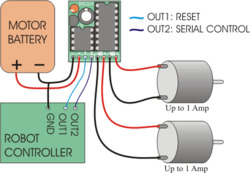Pololu Blog »
Engage Your Brain
A blog by Pololu president Jan Malášek.
New products: D24V7Fx 36V, 600mA low-cost step-down voltage regulators
|
|
|
We just released our D24V7Fx step-down voltage regulator family of basic buck regulators, which generate lower voltages from input voltages as high as 36 V while supporting maximum continuous output currents of 600 mA across all combinations of input and output voltages. Because they are switching regulators, they are much more efficient than linear voltage regulators, especially when the difference between the input and output voltage is large. This family includes six versions with fixed output voltages ranging from 3.3 V to 12 V:
| Regulator | Output voltage | Max continuous output current |
Input voltage range1 | Size | Special features | Price |
|---|---|---|---|---|---|---|
| #5592: D24V7F3 | 3.3 V | 600 mA | 4 V – 36 V | 0.34″ × 0.54″ | Short-circuit protection, thermal shutdown |
$2.75 |
| #5593: D24V7F5 | 5 V | 5.1 V – 36 V | ||||
| #5594: D24V7F6 | 6 V | 6.1 V – 36 V | ||||
| #5595: D24V7F7 | 7.5 V | 7.6 V – 36 V | ||||
| #5596: D24V7F9 | 9 V | 9.2 V – 36 V | ||||
| #5597: D24V7F12 | 12 V | 12.2 V – 36 V | ||||
| Note 1: Minimum input voltage is subject to dropout voltage considerations; see the dropout voltage section of product pages for more information. | ||||||
We manufacture these boards in-house at our Las Vegas facility, so if one of the stock voltages doesn’t fit your needs, we can customize these regulators to output other voltages. If you are interested in customization, please contact us for a quote.
 |
The main distinguishing feature of this regulator is its small size and low cost. At just $2.75 in single-unit quantities, it is our lowest-price regulator yet! We were able to achieve this by having one of our high school summer interns do the board design:
 |
High-school summer intern routing the D24V7Fx regulator PCB, July 2025. |
|---|
I’m kidding about that making the price lower, of course. Our engineers still went over everything, and unlike some competing products you might encounter, we provide detailed performance data such as the quiescent current characteristics:
 |
Also, each production unit is fully automatically optically inspected and tested. We have been putting a lot of effort into automating our testing and packaging, and that is the real key to being able to offer these low prices. More behind-the-scenes information on the robots making our products coming soon!
Introductory special discount! Use coupon code D24V7FXINTRO to try out these new regulators for just $2.22 each.
April 12, 2025 tariff update and new price change notification feature
As a small US-based electronics manufacturer, we have been contemplating tariffs a lot this year, especially over the last several weeks, when our mindset changed from primarily “let’s see what happens” to more of “this could be an existential threat and we need to act right away.” Like much of the world, we were shocked by the April 2 announcement of new, and high, US tariffs on seemingly everything from everywhere and the subsequent dramatic escalation of tariffs on China, which are up to 145%, or maybe 170% or 195% on some electronics components, as I write this on Saturday, April 12.
With the various pauses and extensions and exemptions that are announced almost daily, it might seem that the tariffs are just talk, but we have been getting hit by tariffs of 45-70% on electronics components for the past several months already. Often, these are for integrated circuits that we ordered months ago and that can ship from various countries, and we find out about the extra 70% cost only after we receive the parts. This summary from a recent Arrow Electronics order for some stepper motor driver ICs shows Arrow trying to get ahead of the tariff shocks and how high their estimate had gotten (I am not sure how they are calculating it, and it probably also changes day to day):
 |
Order summary from an April 6 stepper motor driver chip order showing estimated tariff of 144%. |
|---|
We just finally mostly recovered from the pandemic-era chip shortages, and we don’t want to wait too long on reacting as we did then, when some of our key stock was quickly bought up and left us unable to manufacture some products for nearly two years. So, over the past week, we have gone through and assessed the pricing of all of the thousands of products we sell. Since most products have various quantity price breaks and pricing for our distributors, we updated tens of thousands of prices.
Our system is not made for this. When we release products, it’s usually one at a time and we carefully assess our costs and competing products to set what we expect to be good prices. If there are small cost increases over time, we usually absorb them, and if there is a big jump in some component cost, we can reassess and reprice the affected products individually. But here, we are dealing with the sudden, not precisely-specified, and unequal cost change of almost every component. So, the price changes that we have made over the past week have been much less carefully considered and more dependent on formulas based on costs and countries of origin and other data we have available.
Many of the “individual assessments” amounted to looking at prices our programs spit out and seeing if they seemed reasonable, and in many cases we just flagged the item for further review later and accepted the proposed prices or overrode to stick with our old prices. And, in some cases, we had to override to make the prices higher still based on knowing that a particular part was already constrained or getting higher tariffs.
This morning (again, Saturday, April 12) as I started writing this post, I saw news reports that semiconductor devices would be exempted from the latest extra hikes. Even if that applies to the kinds of integrated circuits we use, I think that means the 70% portion that we have already been paying is still staying in place. It’s also not clear to me if things like inductors, which we’re currently paying an extra 45% on are going to stay at 45% or going to 170% or what (basically all commodity inductors in the world come from China as far as I know). Even if they do get some exemptions or the tariffs are walked back more broadly, I suspect the 45% increase will be a new minimum for a while.
These new exemptions announced today should be good news for us, but I find myself feeling deflated as I contemplate more and more effort having to go into constantly repricing everything while looking at bills for extra thousands of dollars in tariffs almost daily. (This post is mostly about the work going into pricing for our customers, but there is also lots of decision making about what to buy now, such as do we get extra material now before prices go up more, or do we hold out hoping for them to go down and risk running out of components? Will the demand still be there for a product if it’s more expensive? And so on.)
Anyway, the point of this post is not to whine or wallow or complain, but rather to give our customers and partners some idea of how we are dealing with the tariffs. Price increases are not pleasant, and we are working on keeping them to a minimum and reducing prices again when we can. We are also quickly developing a new price change notification feature on our website so that you can be notified of price changes on any products you care about:
 |
New price change notification feature. |
|---|
Because things are changing so quickly, we are rolling out this new website feature and I am announcing it before we have the notification email system implemented, so it might be a while before we can start sending out the notifications. I am thinking that until we have it all working and until things stabilize, this can also be a way for us to get feedback about which products might have been badly repriced and that we should prioritize for reassessment.
Please reach out and share your thoughts in the older established ways, too. Especially if you are a customer wondering about the future of some product, please let us know your concerns and we will do our best to give you whatever insight we might have and work with you on prices.
How much did our 305 kW solar plant cost, and was it worth it?
This is the fifth post in a series documenting the installation and first year of operation of Pololu’s 305 kW solar array. Here are the previous posts:
- Part 1: Background starting in late 2022 and how we committed to the $650,000 project by the beginning of January 2023, with a target completion date of May 31, 2023.
- Part 2: Installation from January 2023 through first day of operation on October 5, 2023.
- Part 3: System failures and production results during the first year of operation.
- Part 4: Analysis of electrical costs before and after our system was installed.
In this final post in the series, I will go over the costs and benefits of our solar system, some lessons learned, and my thoughts on whether this has all been worth it. Continued…
Energy costs after a year of operating Pololu's 305 kW solar project
This is the fourth post in a series documenting the installation and first year of operation of Pololu’s 305 kW solar array. Here are the previous posts:
- Part 1: background starting in late 2022 and how we committed to the $650,000 project by the beginning of January 2023, with a target completion date of May 31, 2023.
- Part 2: installation from January 2023 through first day of operation on October 5, 2023.
- Part 3: System failures and production results during the first year of operation.
In this post, we will look at how our solar installation affected our electricity bills. Because operations were so dramatically altered by the pandemic starting in 2020, we have to go back to 2019 for the best baseline for electricity consumption and cost. To maximize the scientific rigor of our observations, we changed as many variables as possible since then, including: Continued…
New products: compact reverse voltage protection and ideal diodes
We just released several small reverse voltage protection and ideal diode boards that can protect your projects from reverse voltage application. We have reverse-voltage protection built into many of our products, and we usually implement it using a P-channel MOSFET, like this:
 |
Reverse-voltage protection using a P-channel MOSFET. |
|---|
This approach is usually more efficient than just using a diode since the MOSFET has a lower voltage drop across it. However, P-channel MOSFETs have worse on-resistances than N-channel MOSFETs of similar prices and sizes. This has not mattered much for our lower-powered products, but that limitation is becoming more apparent as we are developing more products with maximum operating voltages over 40 V. The next common MOSFET voltage above 40 V is 60 V, and at that voltage and with currents above around 10 A, it starts becoming more size-efficient to use an N-channel MOSFET plus an extra chip to manage the additional complexities of controlling the N-channel MOSFET in this kind of application. This is how that circuit looks:
 |
Schematic diagram of the Pololu Reverse Voltage Protectors. |
|---|
Since we are planning on using this approach on several new products, we decided to make standalone product versions as well. Here are how the first products look, using 3×3 mm MOSFETs:
 |
This lets us get up to about 10-12 amps continuous current and an operating range of 4-60 V, which is perfect for most of our products. We tried to make the board as small as possible, and for the input and output connections we are using a new slot approach that lets the boards work with standard 0.1" headers or connectors, 3.5 mm connectors, and 5 mm connectors.
 |
Examples of various connectors that can be used with the Pololu 10A/12A Reverse Voltage Protectors (from left to right: 5mm terminal blocks, 3.5mm terminal blocks, 0.1″ headers). |
|---|
Texas Instruments offers two similar parts for the MOSFET controller. The LM74500 offers the same functionality as the simple P-channel MOSFET, allowing current to flow in both directions as long as the polarity is correct. This is useful for applications such as motor drivers where we want power to be able to flow back from the motor into the battery. There is also the LM74700 version, which makes the circuit function as an ideal diode, allowing current to flow in only one direction. We are offering our boards with both controller options and with two MOSFET options, for a total of four product versions:
| Pololu Item # |
Max current |
On resistance | Reverse current blocking |
Price |
|---|---|---|---|---|
| #5380 | 10 A | < 10 mΩ | no | $1.49 |
| #5381 | 12 A | < 5 mΩ | $1.95 | |
| #5382 | 10 A | < 10 mΩ | yes (ideal diode) | $1.75 |
| #5383 | 12 A | < 5 mΩ | $2.25 |
The datasheets for the LM74500-Q1 reverse voltage protection controller and LM74700-Q1 reverse voltage protection ideal diode controller provide additional information about adding a transient voltage suppressor (TVS) diode across the input as part of a more general input protection circuit. We have pads for an SMB-size TVS on the back side of the board for those interested in adding this kind of protection:
 |
As with our other electronics products, we make these at our Las Vegas, Nevada headquarters, so we can build custom versions with that TVS populated with a part of your choice (typical minimum quantities to make that worthwhile are around 200 pieces).
Are these interesting products? Would you want to see higher-current versions with bigger MOSFETs? Let us know in the comments or on our X and Facebook posts.
Introductory special discount! Try some out for as low as $1.16 each using our introductory special coupon, RVPINTRO (limit 5 per version)!
Notes and pictures from the 2024 ECEDHA Western Regional Meeting at UNLV
Over the last two days, I attended the 2024 Western Regional Meeting of ECEDHA, the Electrical and Computer Engineering Department Heads Association. It was held this year at UNLV, which is only 3 miles (5 km) away from Pololu, in the engineering department’s new Advanced Engineering Building that was just opened earlier this year.
 |
UNLV’s new Advanced Engineering Building, November 2024. |
|---|
I was there representing Pololu as one of five local industry sponsors. The larger companies there were treating it more like a recruiting event, and while we have several UNLV alums working at Pololu along with half a dozen student interns from UNLV, I looked at the event more as an opportunity to meet some of our customers. I also got to see some of UNLV’s new facilities for engineering students and researchers. Continued…
First year production results of Pololu's 305 kW solar panel array
This is the third post in a series detailing our experience over the past two years installing and operating a 305 kW array of 630 solar panels on our building in Las Vegas, Nevada. Here are the previous posts:
- Part 1: background starting in late 2022 and how we committed to the $650,000 project by the beginning of January 2023, with a target completion date of May 31, 2023.
- Part 2: installation from January 2023 through first day of operation on October 5, 2023.
I left off with our first look at the SolarEdge monitoring site on October 5, 2023. It’s nice to see nearly real-time generation results and status. The SolarEdge P1101 optimizers connect to pairs of solar panels, so that is the resolution we can see in the array. Here is a close-up as I write this at 10AM on October 31, 2024, with a section affected by the shadow from an air conditioner circled:
 |
SolarEdge monitoring site solar panel array close-up at 10AM on October 31, 2024. |
|---|
The 1.0.72 pair of panels and 1.0.19 pair of panels at around 130 Wh so far today have generated only about half as much as the nearby panels not affected by the shadows. Continued…
Installation of Pololu's 305 kW solar generation system
 |
This is the second post in a series detailing our experience over the past two years installing and operating a 305 kW rooftop solar system on our building in Las Vegas, Nevada. In the first post, I covered some of the background starting in late 2022 and how we committed to the $650,000 project by the beginning of January 2023, with a target completion date of May 31, 2023. This post covers how the actual installation went. Continued…
Pololu's 305kW solar generation system: Was it worth it?
October 2024 marked one year of operation of our 305 kW rooftop solar power generation system. In this series of posts, I will reflect on our installation and operation experience over the past two years to try to assess whether it was worth it. This first post covers some background leading up to the project and the overall system design. I will detail the installation process, the first full year of operation, and the production and financial results in subsequent posts. Continued…
More Motoron motor controllers!
We recently added six new low-power variants to our Motoron line of basic serial motor controllers: four Mxx550 1- and 2-channel versions, as well as 3-channel versions for Arduino (M3S550) and Raspberry Pi (M3H550).
1- and 2-channel micro motor drivers
The new M1T550, M1U550, M2T550, and M2U550 are single- and dual-channel serial motor controllers in a micro footprint. With a maximum motor supply voltage of 22 V, the Mxx550 versions are a great way to control small motors powered by power supplies up to 12 V and battery packs up to 12 cells in series for alkaline, NiCd, and NiMH, or up to 4 cells in series for LiPo. These are lower-voltage, pin-compatible versions of the Mxx256 models we released earlier this year, which have a maximum motor voltage of 48 V and can deliver slightly more current but are otherwise almost identical.
Here is the full array of tiny Motoron options, including I²C and UART serial interface versions:
| Motoron motor controllers micro versions |
||||
 M1T550  M1U550 |
 M2T550  M2U550 |
 M1T256  M1U256 |
 M2T256  M2U256 |
|
|---|---|---|---|---|
| Control interface: | I²C or UART serial | |||
| Motor channels: | 1 (single) | 2 (dual) | 1 (single) | 2 (dual) |
| Minimum motor supply voltage: |
1.8 V | 4.5 V | ||
| Absolute max motor supply voltage: |
22 V | 48 V | ||
| Recommended max nominal battery voltage: |
16 V | 36 V | ||
| Max continuous current per channel: |
1.8 A | 1.6 A | 2.2 A | 1.8 A |
| Available versions with I²C: |
||||
| Available verions with UART serial: |
||||
| Price: | $12.49 – $14.49 | $15.95 – $17.95 | $16.95 – $18.95 | $23.95 – $25.95 |
3-channel motor drivers for Arduino and Raspberry Pi
We also released larger (but still small!), 3-channel versions in Arduino (M3S550) and Raspberry Pi (M3H550) compatible form factors. These again have a maximum motor supply voltage of 22 V and correspond to the 48 V max M3S256 and M3H256 versions we released in 2022. Here is the full line of larger Motoron serial motor controllers, including the even higher-power, dual-channel Motorons in full-size Arduino Shield or Raspberry Pi Hat form factors:
| Motoron motor controllers Arduino and Raspberry Pi form factor versions |
||||||
 M3S550  M3H550 |
 M3S256  M3H256 |
 M2S24v14  M2H24v14 |
 M2S24v16  M2H24v16 |
 M2S18v18  M2H18v18 |
 M2S18v20  M2H18v20 |
|
|---|---|---|---|---|---|---|
| Control interface: | I²C | |||||
| Motor channels: | 3 (triple) | 2 (dual) | ||||
| Minimum motor supply voltage: |
1.8 V | 4.5 V | 6.5 V | |||
| Absolute max motor supply voltage: |
22 V | 48 V | 40 V | 30 V | ||
| Recommended max nominal battery voltage: |
16 V | 36 V | 28 V | 18 V | ||
| Max continuous current per channel: |
1.7 A | 2 A | 14 A | 16 A | 18 A | 20 A |
| Available versions for Arduino: |
M3S550 | M3S256 | M2S24v14 | M2S24v16 | M2S18v18 | M2S18v20 |
| Available versions for Raspberry Pi: |
M3H550 | M3H256 | M2H24v14 | M2H24v16 | M2H18v18 | M2H18v20 |
| Price: | $20.95 – $30.95 | $34.95 – $44.95 | $59.95 – $69.95 | $115.95 – $124.95 | $59.95 – $69.96 | $95.95 – $104.95 |
The great thing about the Motorons is that you can easily string together or stack multiple controllers, mixing and matching sizes to fit your application. For example, you could use one high-power dual motor version for drive motors on a mobile robot and then add a smaller 3-channel motor controller for additional actuators. This arrangement with three stacked Motorons on an Arduino Uno allows simple control of up to 9 motors:
 |
The common protocol between versions also makes it easy to change motor sizes and to reuse your code between projects. Want to make a bigger version of your first prototype? Just use a higher-power Motoron! Want to make a tiny robot next time? Use a tiny Motoron! Want to… you get the idea.
While the 3-channel boards are designed to stack on Arduinos or Raspberry Pis, they are also easy to use on breadboards:
 |
It may be easy to view the six new Mxx550 Motorons as just lower-voltage versions of the previously available Mxx256 Motorons, but I am especially excited about them because we are able to offer them at a very low price, extending the legacy of the Dual Serial Motor controllers that were among our first products over 20 years ago. We are launching the 2-channel M2T550 and M2U550 at just $15.95, a lower price than the original Dual Serial Motor controller from 2001 (without even adjusting for inflation!).
|
|
The chip shortages of the past several years have made it especially difficult to introduce new products and to keep their prices down, but things are finally seeming to get better on that front. You can see in the tables above that the higher-power 2-channel Motorons are much more expensive; those prices are still elevated because we are limited on some critical components we use there and in our other products. We should be able to manufacture plenty of the new Motorons without being constrained in a similar way.













































